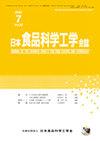在面包制作过程中利用内源酶的加压技术
IF 0.1
4区 农林科学
Q4 FOOD SCIENCE & TECHNOLOGY
Journal of The Japanese Society for Food Science and Technology-nippon Shokuhin Kagaku Kogaku Kaishi
Pub Date : 2022-09-15
DOI:10.3136/nskkk.69.447
引用次数: 0
摘要
我们将高静水压和二氧化碳压力条件应用于玉丹类面包的生产。于丹法的优点是独特的质地和甜味归因于内源性酶。我们在30 C、 以及在40℃时1MPa的高二氧化碳压力 C.这些高压条件抑制了微生物的生长,但能够进行酶促反应。还原糖、谷氨酸和水溶性蛋白质增加,醇溶蛋白和谷蛋白减少。在面包制作中使用高压条件可以促进面包制作过程的多样性。还讨论了高压条件的生物学效应以及这些条件使微生物失活的原因。本文章由计算机程序翻译,如有差异,请以英文原文为准。
Pressurization technology that enables the utilization of endogenous enzymes in breadmaking processes
We applied high hydrostatic and carbon dioxide pressure conditions to the production of Yudane -like bread. The advantages of the Yudane method are the unique texture and sweetness attributed to endogenous enzymes. We employed a hydrostatic pressure of 50 MPa at 30 C, and a high carbon dioxide pressure of 1 MPa at 40 C. These high pressure conditions inhibited microbial growth but enabled enzymatic reactions. Increases were observed in reducing sugars, glutamic acid and water soluble proteins, and decreases were observed in gliadin and glutenin. The use of high-pressure conditions in breadmaking can contribute to a diversity of breadmaking processes. The biological effects of high pressure conditions and the reason why microbes are inactivated by these conditions are also discussed.
求助全文
通过发布文献求助,成功后即可免费获取论文全文。
去求助
来源期刊

CiteScore
0.30
自引率
0.00%
发文量
51
审稿时长
18-36 weeks
期刊介绍:
Information not localized
 求助内容:
求助内容: 应助结果提醒方式:
应助结果提醒方式:


